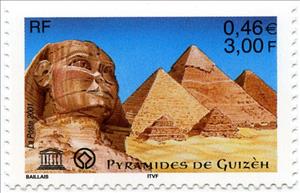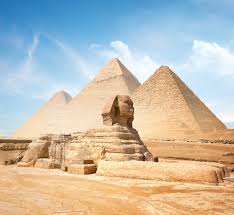Stamp: Pyramids of Giza, Egypt (World Heritage 1979) (France 2001)
Pyramids of Giza, Egypt (World Heritage 1979) (France 2001)
03 December (France ) within release Service-Unesco goes into circulation Stamp Pyramids of Giza, Egypt (World Heritage 1979) face value 3 French franc
| Stamp Pyramids of Giza, Egypt (World Heritage 1979) in catalogues | |
|---|---|
| Yvert et Tellier: | Yt:FR SE124 |
| Michel: | Mi:FR U51 |
Stamp is horizontal format.
Also in the issue Service-Unesco:
- Stamp - Pyramids of Giza, Egypt (World Heritage 1979) face value 3;
- Stamp - Komodo Dragon (Varanus komodoensis) face value 3.80;
Stamp Pyramids of Giza, Egypt (World Heritage 1979) it reflects the thematic directions:
Sculpture is the branch of the visual arts that operates in three dimensions. Sculpture is the three-dimensional art work which is physically presented in the dimensions of height, width and depth. It is one of the plastic arts. Durable sculptural processes originally used carving (the removal of material) and modelling (the addition of material, as clay), in stone, metal, ceramics, wood and other materials but, since Modernism, there has been almost complete freedom of materials and process. A wide variety of materials may be worked by removal such as carving, assembled by welding or modelling, or moulded or cast.
A monument is a type of structure that was explicitly created to commemorate a person or event, or which has become relevant to a social group as a part of their remembrance of historic times or cultural heritage, due to its artistic, historical, political, technical or architectural importance. Examples of monuments include statues, (war) memorials, historical buildings, archaeological sites, and cultural assets. If there is a public interest in its preservation, a monument can for example be listed as a UNESCO World Heritage Site. The Palgrave Encyclopedia of Cultural Heritage and Conflict gives the next definition of monument:
A statue is a free-standing sculpture in which the realistic, full-length figures of persons or animals are carved or cast in a durable material such as wood, metal or stone. Typical statues are life-sized or close to life-size. A sculpture that represents persons or animals in full figure, but that is small enough to lift and carry is a statuette or figurine, whilst those that are more than twice life-size are regarded as colossal statues.
A pyramid (from Ancient Greek πυραμίς (puramís) 'pyramid') is a structure whose visible surfaces are triangular and converge to a point at the top, making the shape roughly a pyramid in the geometric sense. The base of a pyramid can be of any polygon shape, such as trilateral or quadrilateral.
The United Nations Educational, Scientific and Cultural Organization (UNESCO; pronounced /juːˈnɛskoʊ/) is a specialized agency of the United Nations (UN) with the aim of promoting world peace and security through international cooperation in education, arts, sciences and culture. It has 194 member states and 12 associate members,as well as partners in the non-governmental, intergovernmental and private sector. Headquartered in Paris, France, UNESCO has 53 regional field offices and 199 national commissions




